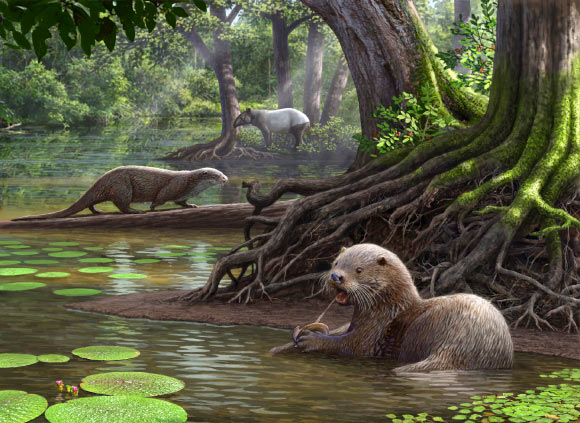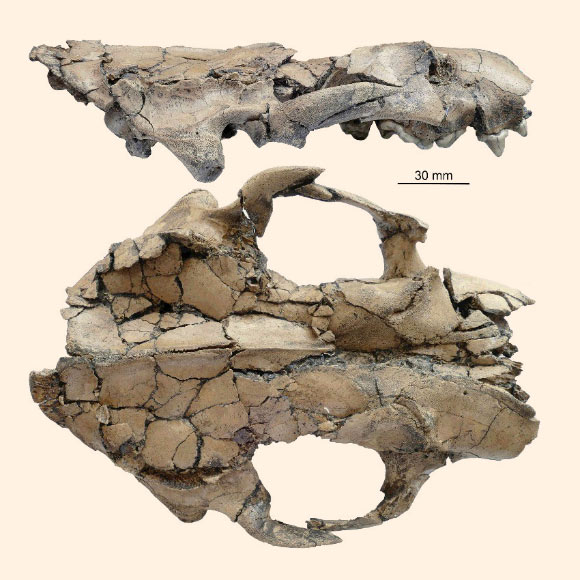An international team of paleontologists has identified a new species of giant otter that lived in what is now China during the latest Miocene, approximately 6.2 million years ago.

Artist’s reconstruction of two individuals of Siamogale melilutra, one of them feeding on a freshwater clam. The tapir in the background is Tapirus yunnanensis. Aquatic plants include water chestnut (Typha) and fox nut (Euryale), and the low shrub in foreground is Sichuan peppercorn (Zanthoxylum). Image credit: Mauricio Anton.
The new otter species is based on a nearly complete cranium, mandible and partial skeletons of at least three individuals from the Shuitangba (‘Water Pond Platform’ in Chinese) fossil site in Yunnan Province, south-western China.
The ancient creature belongs to a little-known genus of extinct otters called Siamogale, according to the paleontologists. This genus goes back at least 18 million years and was previously known only from a single species from Thailand, Siamogale thailandica.
Named Siamogale melilutra, the new species weighed around 50 kg (110 lbs) — almost twice as large as the largest living otters.
“While Siamogale melilutra’s cranium is incredibly complete, it was flattened during the fossilization process. The bones were so delicate that we could not physically restore the cranium,” said team member Dr. Denise Su, from the Cleveland Museum of Natural History.
“Instead, we CT-scanned the specimen and virtually reconstructed it in a computer.”
The CT restoration revealed a combination of otter-like and badger-like cranial and dental feature.
Siamogale melilutra had a large and powerful jaw, with enlarged, bunodont (rounded-cusped) cheek teeth, Dr. Su and co-authors reported in the Journal of Systematic Paleontology.
These characteristics appear to have been adaptations for eating large shellfish and freshwater mollusks, both of which were found in abundance at the Shuitangba site.

A nearly complete cranium of a young adult Siamogale melilutra: right lateral and dorsal views. Image credit: Xiaoming Wang et al.
“From the vegetation and other animal groups found at Shuitangba, we know that it was a swampy, shallow lake with quite dense vegetation,” Dr. Su.
“Multiple otter lineages have low-crowned, bunodont teeth, leading us to ask the question if this was inherited from a common ancestor or if this was convergent evolution based on common dietary behaviors across different species,” added team member Dr. Xiaoming Wang, from the Natural History Museum of Los Angeles County.
“Our phylogenetic analysis suggests that bunodont dentition independently appeared at least three times over the evolutionary history of otters.”
This discovery now has the paleontologists trying to understand other aspects of the life of Siamogale melilutra.
“The discovery of the otter helps solve some questions about otter relationships, but has opened the door to new questions,” Dr. Wang said.
“For instance, why was it so large, how did it crack open mollusks and shellfish for food, and how did it move in the water and on land?”
“Continued future studies by our group will address these fundamental questions and give us a more complete picture of its paleobiology,” Dr. Su added.
_____
Xiaoming Wang et al. A new otter of giant size, Siamogale melilutra sp. nov. (Lutrinae: Mustelidae: Carnivora), from the latest Miocene Shuitangba site in north-eastern Yunnan, south-western China, and a total-evidence phylogeny of latrines. Journal of Systematic Palaeontology, published online January 22, 2017







